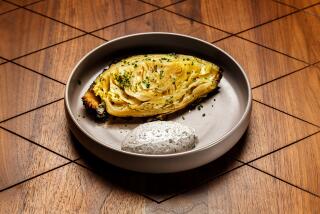Cooked or Cold, Kohlrabi Has Variety of Distinctive Flavors : The winter harvest of the bulbous, turnip- like vegetable promises ‘high-quality stuff’ at reasonable prices.
- Share via
Kohlrabi is a German word for “cabbage turnip.” Not exactly a term that conjures up culinary delight. Nonetheless, this vegetable oddity is worthy of some attention.
The bulbous plant--although a member of the cabbage family--is not a hybrid of that veggie, as its German translation might suggest.
And though it appears to be a root, its turnip-shaped, enlarged stem actually grows above ground. This swollen stem--ranging in size from a golf ball to a tennis ball--is encased in a fibrous skin similar to that of broccoli stalks. Sprouting out of this portion of the plant are numerous lengthy, collard-like leaves that are also edible.
Once the skin has been pared back, you’ll find a crisp flesh that is juicier and more delicate than any turnip you’ll come across. Eaten raw or cooked, kohlrabi bulbs are defined by a variety of mild, yet distinct, flavors. In its raw state, you’ll taste hints of sweetness, radish and broccoli stem flavors. Its leaves offer a kale-collard flavor.
The plant is available most of the year and is raised in two versions--pale green and violet. The flavors and texture do not vary between the two, said Marco Chan, sales manager of Brostoff-Celle, a large distributor of kohlrabi.
“Supplies are better during the spring and summer,” Chan said, “but the winter harvest is normally high-quality stuff.”
Current prices are certainly reasonable. A bunch of four medium-size bulbs--bushy leaves attached--is going for about $1.50. You’ll find kohlrabi at most supermarkets and gourmet markets.
Popular in European communities, kohlrabi has remained a little-used product in the United States, though it has its core of faithful enthusiasts, according to the Fresh Produce Council, a Los Angeles-based industry trade group.
Its versatility might surprise you. The peeled raw bulbs can be sliced, diced or julienned and added to salads and stir fry. Steamed kohlrabi can be marinated in a vinaigrette and served alone or tossed into a salad.
“Kohlrabi is kind of a hit-and-miss thing,” said Ruben Mondragon, produce manager at Mrs. Gooch’s Natural Foods in Thousand Oaks. Mondragon said kohlrabi is a good seller at their Los Angeles area stores, “but here it’s popular with only a handful of customers.”
Educating and familiarizing the public is key, Mondragon said.
“We’ve tried (demonstrations) in the store to show people how to use it in soups and other recipes,” he said. “But it’s been kind of tough getting it to catch on.”
For a simple vegetable side dish, shred the peeled bulbs coarsely with a food processor or hand grater. Saute for a few minutes in a little olive oil or butter until desired tenderness is reached. Season simply with salt and pepper or embellish with your favorite herbs and spices. (A lemon-herb seasoning we tried in the preparation produced a delicious result.)
Vegetable soup lovers should give kohlrabi a try. Toss the cubed or diced bulbs into your usual recipe or puree it to thicken soups, stews and sauces.
When purchasing kohlrabi, look to the leaves for a fresh, healthful appearance, which are free of yellowing, said Fillmore kohlrabi grower Ken Rogers Jr.
When storing the vegetable, be sure to separate the stalks and leaves from the bulbs and refrigerate separately in a plastic bag. This will prolong freshness.
Details
* FYI: Kohlrabi, a member of the cruciferous family, is an ideal nutritional addition to your diet. The plant, including the bulbs and leaves, is an excellent source of vitamins A and C. You’ll also benefit from its high fiber content and low calories.
More to Read
Eat your way across L.A.
Get our weekly Tasting Notes newsletter for reviews, news and more.
You may occasionally receive promotional content from the Los Angeles Times.










